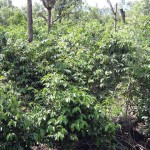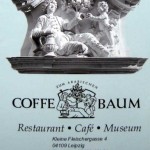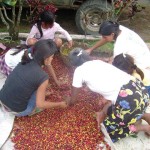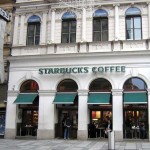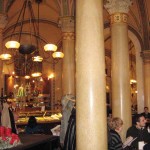How ‘bout a Coffee?
Schumann, Wagner and Goethe met frequently to chat at Coffé Baum in Leipzig, Germany. Established in 1694 and Germany’s oldest coffee house, Coffé Baum still serves satisfied customers and includes a popular coffee museum on the third floor.
In his spare time from his duties as choirmaster at Thomas Church in Leipzig, J.S. Bach composed his Coffee Cantata in 1732, for performance by his special musical group at Café Zimmerman.
Mm! How sweet the coffee tastes,
Lovelier than a thousand kisses,
Mellower than muscatel wine.
Coffee, I must have coffee;
And if anyone wishes to give me a treat,
Ah, then, just give me some coffee!
Coffee houses were popular in Germany at that time, although coffee was not yet acceptable in homes. Beer was the true German drink of the day. Attempts to cultivate coffee in Europe had failed, and coffee came primarily from Brazil.
The first mention of coffee dates to Arab writings of the 9th century, when Maya civilization in Guatemala was on the decline. Legends of coffee’s discovery include that of goats, who became agitated after eating the beans from a bush. The stimulating beans became popular with monks at a local monastery, who had trouble staying awake for evening prayers.
By the end of the 16th century coffee had made its way through the Middle East to Europe, where Italian clergy thought it diabolic. But the pope, after trying it, decided it would be a shame to leave it to the infidels and, rather than condemning it, awarded it the church’s seal of approval. Meanwhile, Santiago de los Caballeros, now La Antigua Guatemala, was officially established in 1543, with monasteries going up all over, aimed to some degree at appeasing the powers that caused repeated natural disasters of earthquakes and volcanoes. The beloved Bishop Francisco Marroquín had died, the Jesuits had begun teaching basic reading, the Franciscans and Dominicans were building elaborate monasteries and the first nuns had arrived in town.
Santiago had two convents for women in the mid-17th century, while London women were banned from cafés, which eventually became men’s clubs. At one point the cafés were closed, considered to be places of sedition. That didn’t last long. They reopened in 11 days.
Although records show no export of coffee until 1853, since the Liberal Revolution of 1871 coffee has been Guatemala’s dominant export.
By the turn of the 18th century cafés had opened in Holland, Vienna, Boston, New York and Philadelphia. Santiago de los Caballeros had no cafés, but it did have seven monasteries, four convents, sixteen orders and three dozen churches.
The first coffee plants were brought to Guatemala from Jamaica and Cuba by the Jesuits in the mid-1700s. They were used as ornamental plants at their monastery in Santiago de los Caballeros. The Jesuits were expelled from Guatemala in 1767, but by then beans or cuttings had been taken to other parts of the country. Despite Guatemala’s fertility for coffee cultivation, coffee plants were primarily ornamental for nearly a century, growing to 12 or 14 feet, with little use other than medicinal, such as “to be taken as a curative to prevent fever,” recorded Regina Wagner in The History of Coffee in Guatemala.
Still, apparently news of the pleasures of drinking coffee had reached Guatemala. Records show that coffee crowned the inaugural banquet celebration in 1745 of the first archbishop of Santiago in his palace next to the cathedral. In the same year King Frederick the Great of Prussia built Sanssouci Palace in Potsdam, near Berlin, where Voltaire visited frequently. The lower level kitchen, now a museum, included a separate room with all the paraphernalia to equip the new custom of entertaining guests with coffee and cake: containers for beans, grinders, water pots, cups, cake molds, cake plates, cake servers. A new, round table was introduced for the living room, on which to serve the coffee and… That said, Frederick himself was a tea drinker, agreeing with those who thought coffee to be a women’s drink, not manly. He preferred wine or beer for his guests to loosen their tongues. Nonetheless, he later recognized the income potential of coffee and established coffee roasting companies.
In Guatemala, what little consumption of coffee there was in the early 1800s was satisfied with local production and imported beans, mills and pots. Dyes of indigo, then cochineal, produced by a beetle, remained the chief exports until mid-century, when a plague hit the beetle. It was bad timing for the beetle, with chemical dyes developing and coffee consumption increasing. By the time the beetle recovered, just a few years later, attention had turned to coffee. Demand was outpacing production. But records show no export of coffee until 1853.
Then began the boom. The Industrial Revolution had increased trade, drawing Guatemala and other Latin American countries into the world economy. The Germans, with their craze for coffee, came and stayed, buying up large properties for coffee cultivation and introducing their custom of drinking coffee in public places. Foreign immigration was welcomed, bringing new ideas, technology and capital.
While the country developed roads, rails and ports, banks and borrowing systems, there was a lot to learn about planting, pruning and processing the crop. And there was a lot to learn about competition, currencies and corporations. Everything was done “to support, stimulate and protect production of the ‘golden bean’,” wrote Wagner. “Ever since the Liberal Revolution of 1871, coffee has been Guatemala’s dominant export.”
The film Out of Africa opens with a Danish woman’s soft, haunting voice lamenting, “I once had a farm in Africa.” A coffee farm, of course. The complicated industry has risen, fallen and risen again, surviving pests and plagues, drought, earthquakes, volcanic eruptions, two world wars and the Great Depression. Alas, the coffee habit has the world hooked.
Coffee has played a major role in Guatemala’s development as well as the world market, where next to oil it remains the most-traded commodity. Prints of globalization are everywhere. While coffee plants still trim the plaza of the old Jesuit monastery in La Antigua, the menu of a lively chocolate/coffee café on the square of Bratislava, Slovakia includes ‘Espresso Guatemala.’ And both Leipzig and traditional Vienna now have Starbucks, which buys coffee from Guatemala.
photos by Jack Houston
- Coffee field near La Antigua
- Coffee Cup
- Coffé Baum, Leipzig, was Germany’s first coffeehouse
- Guatemalan workers sort coffee cherries in Mazatenango
- 21st century coffeehouse, Vienna, featuring coffee from Guatemala
- Traditional café, Vienna, Austria
